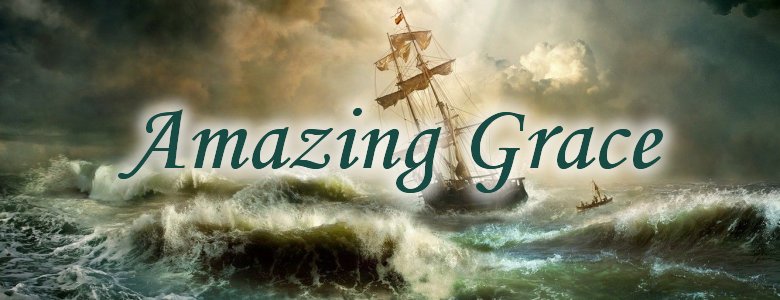PAT GAINES HOME PAGE

AMAZING GRACE
John Newton was born in London July 24, 1725, the son of a commander of a merchant ship which sailed the Mediterranean Seas. At the age of eleven, John went to sea with his father and was able to make six voyages before his father retired. At the age of nineteen, John put to sea on a man-of-war, the H.M.S. Harwich. Conditions were so bad on board the ship that John deserted. When he was captured he was flogged and demoted in ran to seaman. He requested to be transferred to serve on a slave ship which took him to the coast of Sierra Leone. As the servant to a slave trader, he was brutally abused. In 1748, John was rescued by a sea captain who had been a friend of his father. Later, John was the captain of his own slave ship.
Having only early religious instruction from his mother when he was young, John was not a very religious man. On the 10th of May, 1748 during a homeward voyage, John’s ship was caught in a violent storm. He thought that the ship was going to sink so he began to pray for God to have mercy on them. Later, after the storm had passed, John began to remember his prayer and realize that God had indeed saved him and God’s grace had begun to work for him.
For the rest of his life, John celebrated May 10, 1748 as his day of conversion when he subjected his will to a higher power. “Thro’ many dangers, toils and snares, I have already come; ’tis grace has bro’t me safe thus far, and grace will lead me home.” Though John continued in the slave trade for a while after this, he always saw that his slaves were fed and treated well.
Two years later, John married Mary Catlett, a girl that he had loved for many years. Shortly after his marriage, John became seriously ill and he gave up his life on the sea. Newton became a surveyor of tides at Liverpool, where he came to know George Whitefield, deacon in the Church of England, evangelistic preacher, and leader of the Calvinistic Methodist Church. Newton became a disciple of Whitefield. During this period Newton also met and came to admire John Wesley, founder of Methodism.
Newton decided to become a minister and he was subsequently ordained by the Bishop of Lincoln and accepted the curacy of Olney, Buckinghamshire. Newton’s church became so crowded during services that it had to be enlarged. In 1767 the poet William Cowper settled at Olney, and he and Newton became friends. Cowper helped Newton with his religious services and on his tours to other places. They held not only a regular weekly church service but also began a series of weekly prayer meetings, for which their goal was to write a new hymn for each one. They collaborated on several editions of Olney Hymns, which achieved lasting popularity. The first edition, published in 1779, contained 68 pieces by Cowper and 280 by Newton. “Amazing Grace” was one of these listed under the title: “Faith’s Review and Expectation.” The origin of the tune is unknown, but it is believed that it may have been the tune to an old Scottish song or an early American folksong.
AMAZING GRACE
Amazing grace, how sweet the sound,
That saved a wretch like me!
I once was lost, but now am found,
Was blind, but now I see.
’Twas grace that taught my heart to fear,
And grace my fears relieved;
How precious did that grace appear,
The hour I first believed!
Through many dangers, toils and snares,
I have already come;
’Tis grace has brought me safe thus far,
And grace will lead me home.
The Lord has promised good to me,
His word my hope secures;
He will my shield and portion be,
As long as life endures.
Yes, when this flesh and heart shall fail,
And mortal life shall cease;
I shall possess, within the veil,
A life of joy and peace.
The earth shall soon dissolve like snow,
The sun forbear to shine;
But God, who called me here below,
Will be forever mine.